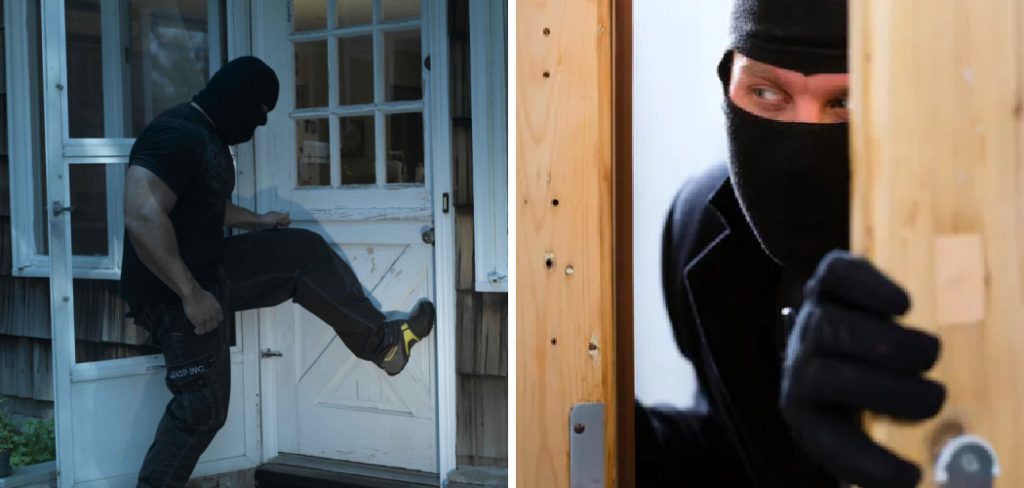Surviving a home invasion requires quick thinking, preparedness, and knowing how to react under stress. This guide offers essential strategies for how to survive a home invasion. From fortifying entry points and creating safe rooms to communicating silently and contacting emergency services discreetly, each step is crucial for maximizing safety. Understanding the psychology of intruders and maintaining calm under pressure are emphasized, along with practical tips for securing valuables and gathering evidence for law enforcement.

By preparing for potential threats and practicing these strategies, individuals can enhance their chances of surviving and minimizing harm during a home invasion. This article empowers readers with actionable advice to stay vigilant, react decisively, and prioritize safety in a crisis situation within their homes.
Benefits of Proactive Measures
Implementing proactive measures can significantly enhance your safety during a home invasion. By taking preventative steps, you not only reduce the likelihood of an invasion occurring but also ensure that you are better prepared to handle one if it does happen. Fortifying entry points with secure locks and reinforced doors can deter potential intruders and buy time in the event of an attempted break-in. Establishing a safe room equipped with essential supplies provides a secure space to retreat to and wait for help.

Additionally, having a well-thought-out communication plan that includes discreet methods for contacting emergency services can ensure that help arrives quickly without alerting the intruder. Proactive measures also include regular drills and mental preparation, which can help you remain calm and decisive under pressure. Ultimately, proactive measures not only enhance physical security but also provide peace of mind, knowing that you are prepared to protect yourself and your loved ones.
10 Methods How to Survive a Home Invasion
1. Establish a Safe Room
One of the most crucial steps in surviving a home invasion is having a designated safe room. This should be a room with a sturdy door, a lock, and ideally, no windows. Stock your safe room with essential supplies such as a phone, flashlight, first aid kit, water, and non-perishable food. Ensure everyone in your household knows how to quickly and quietly get to the safe room in an emergency. The goal is to create a secure space where you can wait for help to arrive without putting yourself at further risk.
2. Install a Comprehensive Security System
Investing in a robust home security system can deter intruders and alert you to their presence. Choose a system that includes motion detectors, door and window sensors, surveillance cameras, and a loud alarm. Ensure the system is monitored by a security company that can alert law enforcement on your behalf. Regularly test and maintain your security system to ensure it functions correctly. Additionally, use security signage and visible cameras to discourage potential intruders.

3. Develop and Practice an Emergency Plan
Having a well-thought-out emergency plan is essential for surviving a home invasion. Discuss and rehearse the plan with all members of your household, including children. Your plan should include steps for getting to the safe room, contacting emergency services, and signaling for help. Practice the plan regularly to ensure everyone knows their role and can act quickly under stress. Consider different scenarios and adapt your plan accordingly to cover various potential threats.
4. Maintain Situational Awareness
Being aware of your surroundings can give you valuable time to react in a home invasion. Pay attention to unusual noises, unfamiliar vehicles, or strangers loitering near your home. Keep doors and windows locked, even when you are at home, and use peepholes or security cameras to identify visitors before opening the door. Trust your instincts; if something feels off, take precautions immediately. Maintaining situational awareness helps you recognize threats early and respond effectively.
5. Strengthen Entry Points
Fortifying your home’s entry points can slow down or deter intruders. Install solid core or metal doors with deadbolt locks on all exterior entrances. Reinforce door frames with strike plates and door jamb reinforcements. Use security bars or dowels in sliding doors and windows to prevent them from being forced open. These measures make it more difficult for intruders to gain access and give you additional time to react and get to safety.
6. Utilize Defensive Tools
Having defensive tools readily available can help protect you during a home invasion. Consider keeping pepper spray, a personal alarm, or a legally owned firearm in your safe room or within easy reach. Ensure you are trained in the proper use of these tools and understand the legal implications of using them in self-defense. Remember, the goal is to protect yourself and your loved ones, not to engage the intruders directly. Defensive tools can provide an additional layer of security and give you the confidence to respond effectively.

7. Communicate with Authorities
In the event of a home invasion, contacting law enforcement is a priority. Keep a phone in your safe room and program emergency numbers into your phone for quick access. When calling 911, provide your address, describe the situation, and stay on the line until instructed otherwise. If you cannot speak freely, use a text-to-911 service if available, or use code words to convey your situation. Effective communication with authorities can expedite their response and increase your chances of a safe resolution.
8. Use Diversion Tactics
Diversion tactics can buy you time and confuse intruders. Consider installing motion-activated lights and alarms outside your home to startle intruders and draw attention to their presence. Inside, keep a loud alarm or a panic button in your safe room to alert neighbors and scare off intruders. Use distractions such as throwing objects or activating other alarms to divert the intruders’ attention while you move to a safer location. These tactics can disrupt the intruders’ plans and give you a critical advantage.
9. Stay Calm and Think Clearly
Remaining calm and thinking clearly is crucial in a home invasion. Panic can cloud your judgment and hinder your ability to make rational decisions. Take deep breaths, focus on your emergency plan, and move deliberately to your safe room or designated area. Communicate calmly with family members and coordinate your actions. Staying composed helps you respond effectively and increases your chances of surviving the ordeal. Practice mindfulness and stress management techniques to prepare yourself for high-stress situations.
10. Seek Professional Training
Consider seeking professional training in self-defense and emergency response. Many organizations offer courses on home defense, situational awareness, and personal safety. These courses can teach you valuable skills such as how to escape from restraints, defend against an attacker, and administer first aid. Professional training can boost your confidence and preparedness, providing you with the knowledge and skills needed to survive a home invasion. Regularly update your training to stay informed about the latest safety techniques and strategies.
Things to Consider When Securing Your Home
When securing your home, it’s essential to be thorough and proactive. Here are some key factors to consider:
- Evaluate Your Neighborhood: Understand the crime rates and specific threats in your area. This knowledge will help you tailor your security measures accordingly.
- Prioritize Visibility: Well-lit exteriors, trimmed bushes, and visible security cameras can deter potential intruders by eliminating hiding spots and increasing the risk of being seen.
- Door and Window Quality: Ensure that all doors and windows are not only locked but made of solid materials that are difficult to break. Reinforcing door frames and using double-glazed windows can add an extra layer of security.
- Alarm System Effectiveness: Invest in an alarm system with features that match your needs. Choose systems with real-time alerts, remote access, and integration with other smart devices in your home.
- Regular Maintenance: Regularly inspect and maintain all security features, including locks, cameras, and alarms, to ensure they are functioning correctly when needed.
- Safe Room Accessibility: Your safe room should be easily accessible from various points in your home, ensuring that all family members can reach it quickly in an emergency.
- Community Involvement: Engage with your neighbors and form or join a neighbourhood watch group. A connected and vigilant community can greatly enhance the security of the entire area.

By carefully considering these aspects, you can create a comprehensive and effective security plan to protect your home and loved ones.
Conclusion
Surviving a home invasion requires a combination of preparation, situational awareness, and the right mindset. By establishing a safe room, installing a comprehensive security system, developing and practicing an emergency plan, maintaining situational awareness, strengthening entry points, utilizing defensive tools, communicating with authorities, using diversion tactics, staying calm, and seeking professional training, you can significantly increase your chances of surviving a home invasion.
Prioritize your safety and that of your loved ones, and take proactive measures to protect your home from potential threats. With the right preparation and response, you can navigate a home invasion situation effectively and emerge safely. Now that you know how to survive a home invasion. While it does take a few steps each time, hopefully now you understand the process and why it’s worth taking the extra step to make sure your floor is properly cared for. So don’t wait any longer, take action today!
About
Safety Fic is a distinguished figure in the world of Diy design, with a decade of expertise creating innovative and sustainable Diy solutions. His professional focus lies in merging traditional craftsmanship with modern manufacturing techniques, fostering designs that are both practical and environmentally conscious. As the author of diy, Safety Fic delves into the art and science of Safety Fic-making, inspiring artisans and industry professionals alike.
Education RMIT University
(Melbourne, Australia) Associate Degree in Design (Safety Fic) Focus on sustainable design, industry-driven projects, and practical craftsmanship. Gained hands-on experience with traditional and digital manufacturing tools, such as CAD and CNC software.
Nottingham Trent University
(United Kingdom) Bachelor’s in diyfastly.com and Product Design (Honors) Specialized in product design with a focus on blending creativity with production techniques. Participated in industry projects, working with companies like John Lewis and Vitsoe to gain real-world insights.
Publications and Impact
In diy, Safety Fic his insights on indoor design processes, materials, and strategies for efficient production. His writing bridges the gap between artisan knowledge and modern industry needs, making it a must-read for both budding designers and seasoned professionals.
